
Impala
Name
Impala
Appearance
The impala is the most common antelope found in the bushveld of South Africa. They have a rufous-fawn colour hide with a white underbelly and are graceful in stature. They measure around 900 mm at the shoulders, with rams weighing about 60 kg and females 40 kg. The impala has a black stripe that runs from the top of the rump all the way down to the back of the thighs.
Only males have lyre-shaped horns that are 700 mm in length. The lower hind legs possess glands that lie beneath tufts of black hair.
Impala Diet
Considered a mixed feeder, the impala grazes on various shrubbery and grass found on flat terrains in South Africa. They will also feed on Acacia pods and certain fruits if it is available.
Impala Breeding
Impala calves are born during the summer months in South Africa, after a gestation period of 6 months. The ewes become sexually mature at the age of two years, while males can start mating at as young as 1 year. However, young males are prevented from producing by much older territorial rams in the herd.
Impala Behaviour
Known for their glorious leaps over the bushveld plains of South Africa, the impala are sociable animals that live in large herds. Two types of herds exist within the impala populations, which are the breeding and bachelor herds. Rutting between males occurs during the winter. Young males live in bachelor herds, while established males with territories become solitary. The female impala all live in breeding herds.
Impala Habitat
The impala inhabits the woodland and savannah regions found in the north and eastern provinces of South Africa and beyond.
Predators
The impala falls prey to almost all big predators found in the wild of South Africa. As a result, the impala are always on the alert. Should one of them spot danger, it will give a warning snort causing the whole herd to scatter in different directions. To witness the impala jump to incredible heights of 3 to 12 metres high is a truly a spectacle to behold.
Spoor Description
Impala hooves are 4-6 cm long and have a sharp, neat and pointed shape.
Field Notes
The impala are also referred to as the McDonald's of the bushveld in South Africa due to their large populations and being the most common prey to predators. The unique black markings on their rump also somewhat resemble the company logo.
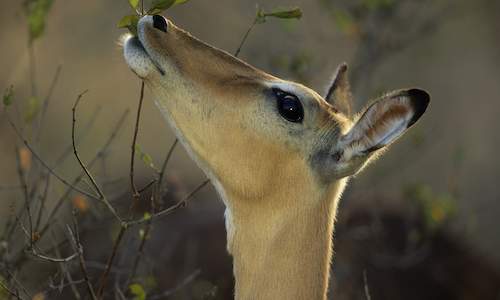
Bushveld ecotone species - woodland areas especially Acacia and Mopane woodland, needs cover and water....
more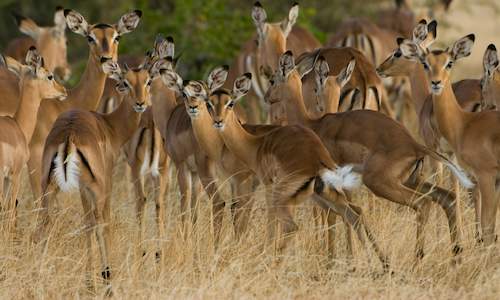
At the end of January, shorter day lengths trigger an increase in testosterone in the males and they separate out of their bachelor groups a...
more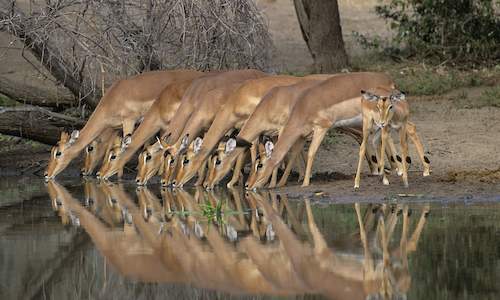
They have a darker colour on their backs than on their flanks and the flanks are darker than the pale belly....
more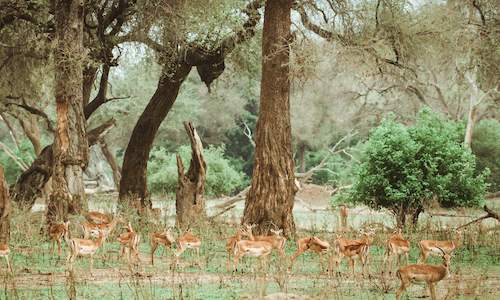
Impala are very common antelope in the Lowveld but they are also one of the most superbly adapted species in this area....
more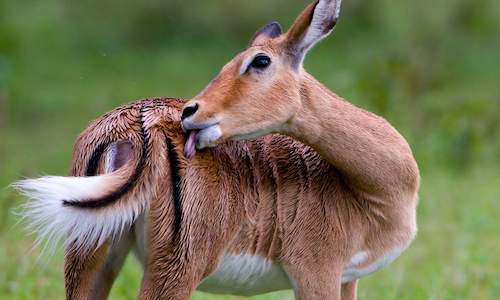
Impala typically inhabit ecotone regions, the transitional zone between two types of habitat, in this case between grassland and woodland....
more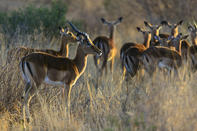
 Bushveld ecotone species - woodland areas especially Acacia and Mopane woodland, needs cover and water....
Bushveld ecotone species - woodland areas especially Acacia and Mopane woodland, needs cover and water.... At the end of January, shorter day lengths trigger an increase in testosterone in the males and they separate out of their bachelor groups a...
At the end of January, shorter day lengths trigger an increase in testosterone in the males and they separate out of their bachelor groups a... They have a darker colour on their backs than on their flanks and the flanks are darker than the pale belly....
They have a darker colour on their backs than on their flanks and the flanks are darker than the pale belly.... Impala are very common antelope in the Lowveld but they are also one of the most superbly adapted species in this area....
Impala are very common antelope in the Lowveld but they are also one of the most superbly adapted species in this area.... Impala typically inhabit ecotone regions, the transitional zone between two types of habitat, in this case between grassland and woodland....
Impala typically inhabit ecotone regions, the transitional zone between two types of habitat, in this case between grassland and woodland....